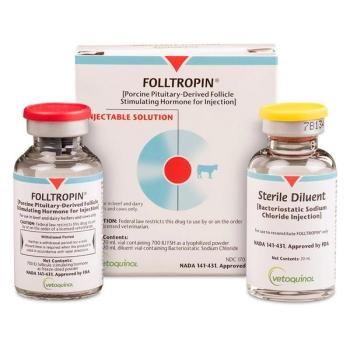
Urinalysis offers a noninasive, rapid screening for canine cancer detection
This is the first rapid test using urine developed by the Virginia Tech College of Engineering, College of Agriculture and Life Sciences, and the Virginia-Maryland College of Veterinary Medicine
Cancer is the leading cause of death in adult dogs1 with 50% of canines over age 10 dying from this disease.2 Because of its prevalence, veterinary researchers can continuously working to find better options for diagnostic and early detection techniques. One development from PetDx, is a
The decision to use urine stemmed from the understanding that cancer and cancer treatment is known to dysregulate renal structure and function and affect urine composition.5 Researchers had confidence in using a Raman spectroscopy-based technology after successful results using the same technique in other studies on chronic kidney disease, diabetic nephropathy, renal effects of COVID-19 disease, microhematuria, bladder cancer, and chronic Lyme disease.3
The methodology used for the study included urine samples collected with voiding, cystocentesis, or catheterization from 89 dogs with no history or evidence of neoplastic disease, 100 dogs diagnosed with cancer (1 of 4 common types including lymphoma, urothelial carcinoma, osteosarcoma, and mast cell tumor), and 16 dogs diagnosed with non-neoplastic urinary tract or renal disease.3 Employing an innovative approach of Raman spectroscopy, researchers examined the urine samples and identified distinct molecular patterns. Notably, cancer-afflicted subjects exhibited a distinctive "fingerprint," suggesting the potential utility of this method for detecting the presence of cancer.4
“If a new patient comes into the clinic and provides a urine sample, we can compare it against our database of urine scans to determine if the sample more closely matches a cancer fingerprint or a healthy fingerprint,” said Ryan Senger, MS, PhD, associate professor in the Department of Biological Systems Engineering, in the university release. “With the research that we have done so far, we were more than 90 percent accurate at being able to tell if a new sample had cancer fingerprint or a healthy fingerprint.”4
According to Virginia-Maryland College of Veterinary Medicine, blood tests can have an accuracy rate of around 60%,4 and tend to be costly with required laboratory procedures. This new urine screening method offers a rapid initial assessment of a dog's potential cancer markers, eliminating the need to wait for blood test results. Furthermore, it holds the potential for convenient at-home testing in the future.4
“Owners could go from paying for expensive testing every few months, to having a urine screening done once every few months, depending on the dog’s risk for cancer, if they wanted to,” said Nikolaos Dervisis, DVM, PhD, DACVIM (Oncology), associate professor of oncology at Virginia-Maryland College of Veterinary Medicine. “This screening would allow veterinarians to decide if further comprehensive testing is needed based on the results.”4
Scanning each urine sample was completed in less than 5 minutes with multiple laser scans. The results showed that with an identified spectral fingerprint in participates’ urine, a 92.7% overall accuracy for a cancer vs. cancer-free designation was discovered.3 from these positive results, researchers are hoping to expand the test’s capabilities to determining the best treatment for therapy for diagnosed patients. They are also hopeful that it can evaluate the tumors and detect any reoccurring cases, if applicable. If research advances in these areas show positive results as well, the Virginia Tech team will investigate how to extend its use to other animals and even human health studies.4
John Robertson, VMD, PhD, research professor in the Department of Biomedical Engineering and Mechanics, said, “We could potentially measure responses to medicine and chemotherapy in dogs already undergoing treatment, then monitor those dogs to see how they're doing. Can we differentiate the kind of diseases we screen for? Which patients are responding to drugs and why? We’re currently working to collaborate with other institutions to further explore how all these factors can be beneficial.”4
A more in-depth assessment of the study with methodology and results can be found in Frontiers in Veterinary Science.3
References
- Fleming JM, Creevy KE, Promislow DE. Mortality in North American dogs from 1984 to 2004: an investigation into age-, size-, and breed-related causes of death. J Vet Intern Med. 2011;25(2):187-98. doi: 10.1111/j.1939-1676.2011.0695.x
- Beltrán Hernández I, Kromhout JZ, Teske E, Hennink WE, van Nimwegen SA, Oliveira S. Molecular targets for anticancer therapies in companion animals and humans: what can we learn from each other? Theranostics. 2021;11(8):3882-3897. doi: 10.7150/thno.55760
- Robertson JL, Dervisis N, Rossmeisl J, et al. Cancer detection in dogs using rapid Raman molecular urinalysis. Front Vet Sci. 2024;11. doi.org/10.3389/fvets.2024.1328058
- Brittner B. Innovative screening can detect 'cancer fingerprint' in dogs. Virginia Polytechnic Institute and State University. February 7, 2024. Accessed February 9, 2024.
https://news.vt.edu/articles/2024/02/coe-innovative-dog-cancer-screening.html - Hottendorf GH, Nielsen SW. Collagen necrosis in canine mastocytomas. Am J Pathol. 1966;49(3):501-513.
Newsletter
From exam room tips to practice management insights, get trusted veterinary news delivered straight to your inbox—subscribe to dvm360.






